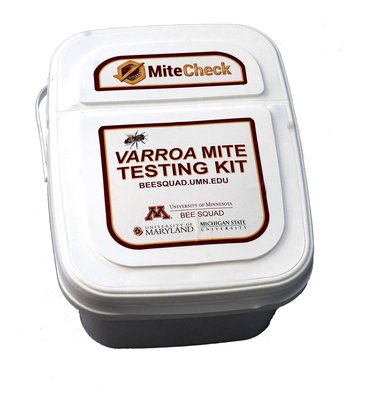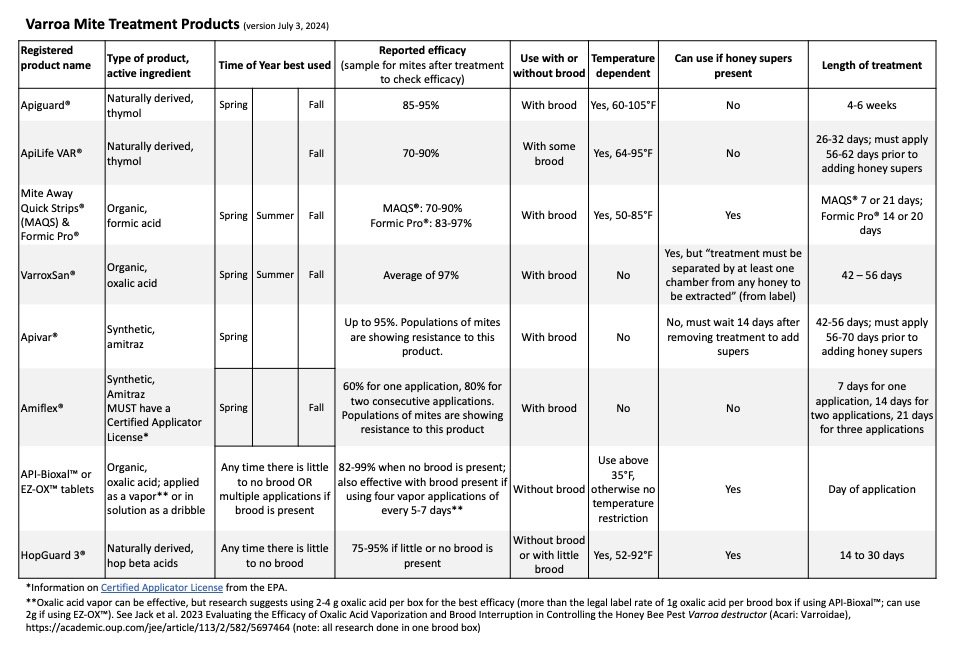Monitoring Varroa Mites
LINK TO THE NEWEST MITE TESTING KIT BROUCHURE (June 3, 2024)

Why test for varroa mites?
In the U.S., the parasitic mite Varroa destructor (varroa mite) is the primary cause of honey bee colony death. Varroa mites harm colonies by spreading viruses and feeding on the developing and adult bees. If beekeepers do not manage varroa mite infestations, colonies are likely to die in fall or winter.
Mites can spread from colony to colony, on the backs of robbing and drifting bees. If you don't monitor and manage mites, you may be putting your neighbors' bees at risk. In urban areas, horizontal mite transmission (spreading mites) is a serious threat to honey bee health.
The two primary methods of sampling adult bees to estimate mite levels in a colony are the alcohol wash and powdered sugar roll.
Alcohol Wash The alcohol wash is the fastest and easiest field mite monitoring method. This lethal sampling method does not noticeably impact a populous colony. To perform the test, submerge sampled bees in alcohol, shaking and swirling them to dislodge the mites from the bees. Then, shake the varroa mites through a mesh screen and count them. Repeat the process until you find no additional varroa mites.
The alcohol wash mite sampling method is more reliable with fewer variables that affect the efficacy as compared to the powdered sugar roll test (e.g., humidity that results in the sugar sticking to the bees, how hard the bees are shaken). For simple instructions on the alcohol wash see this guide. Dish soap can also be used instead of alcohol, however the mites can be difficult to see through the suds when using this straining method.
Powdered Sugar Roll University of Nebraska developed a testing method called the “powdered sugar roll” where most of the bees in the sample survive (unless the bees get wet or are shaken too hard). The powdered sugar roll is a test that covers sampled bees in powdered sugar to dislodge varroa mites from the adult bees. Once dislodged, shake varroa mites out of the bee sample through the mesh screen and count them. This method relies on skill developed through practice. Avoid using the powdered sugar roll in humid weather or if the bees are on a nectar flow because the powdered sugar can dissolve and become sticky making the sample invalid. Avoid using stale or clumpy powdered sugar as it does not coat the bees well. If the shaken bees are not coated in a dusting of dry, white powdered sugar when you put them back into their colony, the test is invalid.
When to monitor for mites?
Monitor mites at least once per month during the active beekeeping season to help confirm that your varroa mite plan is working. Repeated testing increases confidence in the results and can catch unexpected spikes in mite populations. Check mite levels before and after management in case your control action was not as effective as expected. Identify if mites re-infest colonies after management. Monitor all colonies. Mite levels often vary among colonies in the same yard, even when colonies are managed the same.
How low should mite populations be in your colony?
Keep varroa mite levels low year round. Keep mite levels below 1 mites per 100 bees in the spring and 2 mites per 100 bees the rest of the year. Protect your bees from mite and virus damage. Make a robust varroa mite management plan. Rely on the most recent guidelines from university Extension and your past data and experiences. Keep records of your management practices, treatments, and mite levels. Verify and adjust your plan based on testing.
Treating for Varroa Mites: When & What?
Take action throughout the beekeeping season to keep varroa mite levels low. If you wait until levels are high, it may be too late for your colony. All colonies are at risk of dying from varroa mites and viruses, even if there are low or no mites in a mite check. Colonies that show zero or low numbers of mites in a test should still be managed to prevent mite populations from growing.
There are many ways to manage mites, some more complicated than others. This guide is intended for beekeepers who need a basic, tried and true method to keep their bees alive. As you build confidence and skill as a beekeeper, experiment with management methods that require advanced techniques and knowledge of bee biology. Use the recommendations below to manage mite populations in Minnesota honey bee colonies.
For instructions on HOW to apply treatments, see the Honey Bee Health Coalition page on varroa management.
Tips on management:
- The most effective time to employ a miticide is in a broodless colony when all the mites are on adult bees. Mites on adult bees are more easily killed; mites in brood are difficult to get rid of because the wax cappings on the brood cells protect the mites as they reproduce underneath.
- The hardest time control mite populations is when the colony has lots of brood.
- A spring mite control helps reduce the likelihood of high mite levels in late summer, when large brood nests make it hardest to control mite populations effectively.
- Always read the label. Follow the temperature limits. Wear the correct protective gear to protect yourself.
The below biology-based treatment schedule has been an effective method for us to manage mite populations in our colonies. However, we cannot guarantee your colonies will not have issues with mites using this method. Monitoring often will help you catch unexpected spikes in your mite populations, and adjust your treatment plan accordingly.
Spring
- Package (suggested): Treat with oxalic acid dribble or vapor 5 to 7 days after installing the package.
- Nuc: Ask the supplier if and how they managed mites in the spring. If they did not manage mites, use HopGuard® or use a different miticide once the bees occupy a full deep box or two.
- Overwintered colony: treat with Mite Away Quick Strips®, Formic Pro®, or Apiguard®. Mite Away Quick Strips® and Formic Pro® can be applied when honey supers are on the colony; other treatments must be complete before honey supers are applied. Can also use oxalic acid vapor four times at 5-7 days apart**(but see note below table).
Summer
- If mite levels are above 2 mites per 100 bees, use Mite Away Quick Strips® or Formic Pro® as these products are safe to use with honey supers. Can also use oxalic acid vapor four times at 5-7 days apart**(but see note below table).
Before August 20
- Remove supers and treat with Mite Away Quick Strips®, Formic Pro®, Apiguard®, or ApiLife VAR®. Can also use oxalic acid vapor four times at 5-7 days apart**(but see note below table).
- Check mites after treatment and every two weeks in fall to see that the treatment worked and if there is mite re-infestation from nearby colonies.
Fall when no brood is left in the colony
- Treat with oxalic acid dribble or vapor in late fall. Can use HopGuard®, but remove the strips before winter.
Guidance on Using Mite Treatment Products
The below chart shows when each of the registered products can be used as mite control. Using the products when they are most effective can reduce the overall number of treatments needed. Always read and follow the label.
Note about VarroxSan®: this is a new product and should be available in mid-August. Read about this oxalic acid product with an extended release on the manufacturer's website.

*Information on Certified Applicator License from the EPA.
**Oxalic acid vapor can be effective, but research suggests using 2-4 g oxalic acid per box for the best efficacy (more than the legal label rate of 1g oxalic acid per brood box if using API-Bioxal™; can use 2 g if using EZ-OX™). See Jack et al. 2023 Evaluating the Efficacy of Oxalic Acid Vaporization and Brood Interruption in Controlling the Honey Bee Pest Varroa destructor (Acari: Varroidae), https://academic.oup.com/jee/article/113/2/582/5697464 (NOTE: all research done in one brood box)
